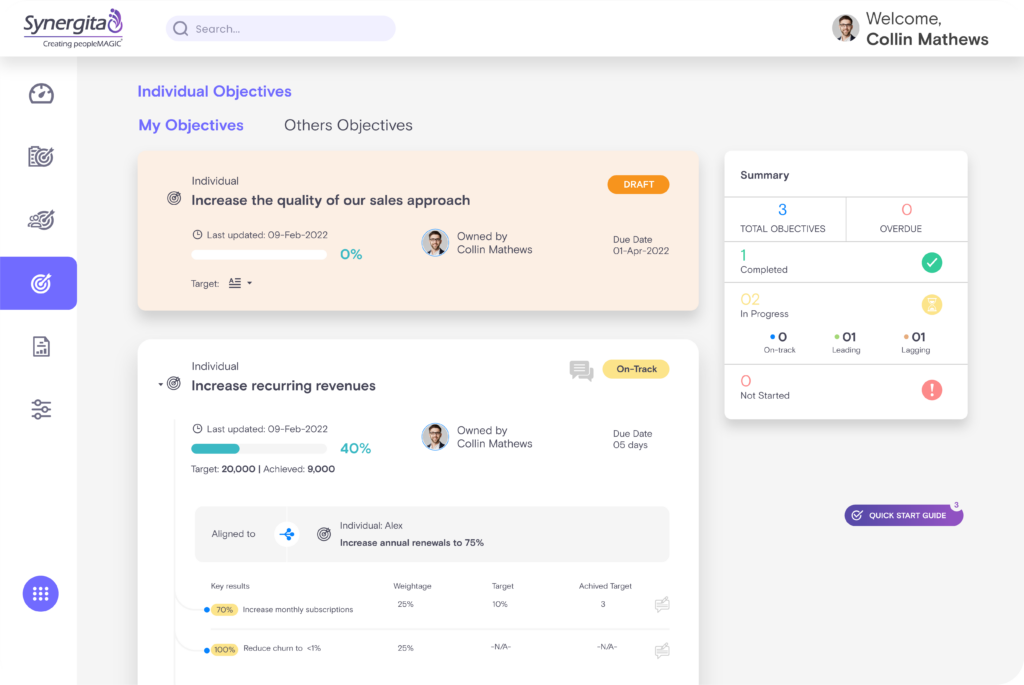OKR for your specific Business Focused Team
Objectives and Key Results (OKR) is a goal-setting platform that helps businesses to achieve even their stretch goals. This has been the buzz line in all the OKR-related blogs. And it instills FOMO (Fear of Missing Out) in the minds of new business owners and corporate leaders. But before embarking on the OKR journey, companies should think about if the OKR framework is really necessary for their company growth. If yes, then connect with an OKR expert and implement the required tool to track goals.
If the answer is no, then do not take unnecessary risks that hinder the growth of the organization.
There are many OKR benefits. Achieving alignment, transparency, and goals within the stipulated time would become easier. Effective communication and collaboration would become a part of the company culture, thus, make it one of the great motivators of the employees’ performance. Besides, the employees would always be engaged as now they would be accountable for their respective tasks, which is one of the prominent features of OKR.
Misleading Assumptions About OKR
In recent days, Objectives and Key Results (OKR) is gaining popularity as it seems to be an effective methodology in these uncertain times to keep the remote workers engaged and motivated. And, most of the OKR advocates have taken Google as a great example to prove their points in the meetings.
Once the plan is approved, the company moves forward with the implementation process. From the top management to every individual in the company gets exposed to the OKR tool, and everyone starts experimenting with the tool but no much focus on the process itself.
Business leaders assume bringing in OKRs can help the company attain growth like many other global companies but it is a myth. Companies like Google, Twitter, LinkedIn are well-established businesses with a strong corporate culture. Every employee lives out the core values of the company, and they understand the process and contribute toward it. They believe in what their organization believes.
OKRs worked for those multinational companies, and so thinking that it could work for you too is absolutely a wrong path to take. Every company has a different kind of environment, a different set of employees with varied backgrounds, and different company culture. In Google, every employee is allowed to work autonomously and held accountable for their tasks.
Do you follow the same in your company too? If not, you should take a step back and give more time to roll out OKRs to the entire organization.
How about going step-by-step?
Which is the Best Way to Roll Out OKRs to the Whole Organization?
Business goals are always set first, and every team set goals for themselves. If you are already following a goal-setting method, do not immediately switch to OKRs without considering how it would work for your company.
Initially, leverage OKRs for the overall business objective and top executives, who already have a good deal of knowledge on how this novel goal-setting method works. The OKRs can also be short-termed, and so they will show you your progress with this process at the end of the first quarter but do not be quick in judging the results. Roll them out for the next quarter too and compare the results from the pre-OKR stage, first quarter, and the second quarter.
Now if you know that they are working for your top executives, implement the process to one department or one team or one set of employees like HiPo (High Potential) employees or below-average employees and see the end results. If things do not go the way you have planned, you must drop OKRs for that particular team or department.
Try OKRs for all the teams separately and analyze the outcomes. For example, see which teams they work well or for which they do not and the reasons behind it. After going through all the data, if it seems beneficial and that’s the time you should roll it out to the entire organization.

OKRs are Not Just About Tools, But Processes
After deciding to use OKRs, everyone would plan to use the right tool to track and monitor the progress of the employees toward the goals. But before that, the most important thing to do is, explain the in-depth concept of OKRs to your employees and why you have decided to adopt the methodology for the company.
If employees know the purpose of every action, they tend to be more involved in the organization’s growth. Conduct regular meetings with your employees to talk more about OKRs and ask them to create sample OKRs. Once they are clear about the concept, you can look for an effective OKR solution that is customizable and affordable.
In fact, most OKR companies today provide consultations before providing a demo about their tool. You can use the service along with the tool to increase the success rate of OKRs. Sticking to the core concept of OKR might be a difficult task but that is where the digital solutions come into the picture, to keep the company right on track.
Synergita’s Objectives and Key Results (OKR)
Synergita’s OKR helps you to establish the right priorities and focus for your teams by defining the critical outcomes and company objectives you aspire.
Synergita’s OKR also has a powerful dashboard that helps businesses to make informed decisions regarding employee goals and also the dashboard design and placement make it easily accessible and comprehensible.
The employers and employees can track the success percentage at the end of each quarter and in addition to that, they can look at how much they have achieved from time to time with the help of numerical and visual representations.
In a Nutshell
OKRs are a boon if the companies learn how to use them to achieve success. Every company can have 3 to 5 overall objectives and every objective can have 3 to 5 key results. Having too many objectives or key results can bring you far from your goals. Therefore, know the basics, experiment with them first, and then roll them out to the entire organization by seeking guidance from an OKR expert and adopting a powerful OKR solution.

